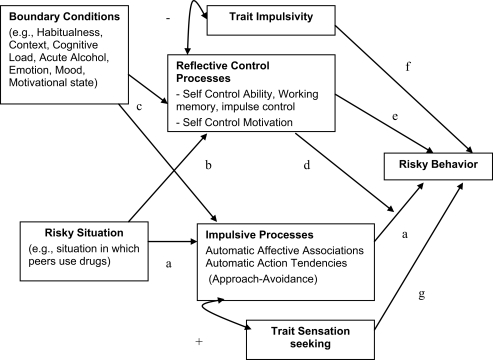Figure 2.
A framework for the prediction of impulsive behavior by impulsive vs. reflective processes and associated boundary conditions (moderators). Pathway a represents the specific impulsive (associative) processes activated in the specific risky situation, which automatically activate action tendencies, usually approach. This is positively related to a general tendency to seek rewarding and stimulating experiences and sensitivity to reward (trait sensation seeking). Pathway b represents EC processes activated in the risky situation, including self-control ability and motivation to control. Pathway c represents the moderating effects of boundary conditions, which moderate the relative influence of pathways a and b. For example, after drinking alcohol, the impulsive (associative) processes get stronger, while the reflective processes get weaker. Pathway d represents the moderation of (behavior-specific) impulsive processes by reflective processes, as demonstrated in recent studies (see also Figure 1). Pathway e represents “rational risk taking”: after weighing pros and cons (reflective process), the risk is taken. Question addressed in the re-analyses presented here is whether individual differences in trait impulsivity can be viewed as a moderator, similar to executive control capacity or self-control, or whether it uniquely predicts risky behavior, independent of specific impulsive and reflective processes (pathway f). In addition, it is tested whether the moderated pathway of specific associations is robust, for controlling for trait impulsivity and sensation seeking (pathways f and g).

